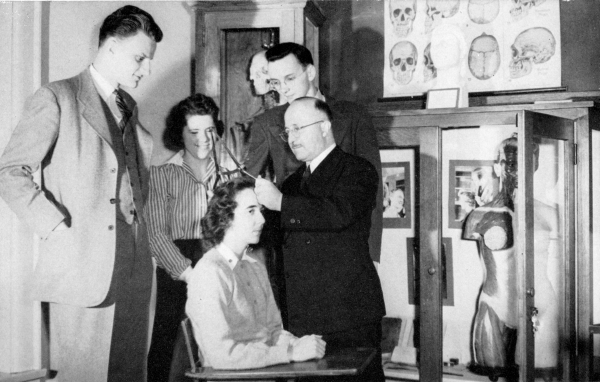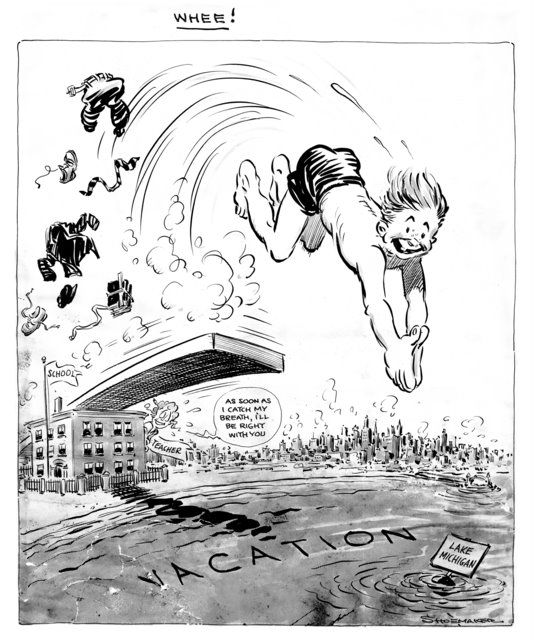This charming sketch of Dr. J. Oliver Buswell, Jr., drawn by Dewitt Whistler Jayne, accompanied by Buswell’s written greeting to the student body, is published in the 1935 Tower, wherein the president briefly thanks the staff for their excellent work on the current edition and for “…so tastefully furnishing the office during your second year in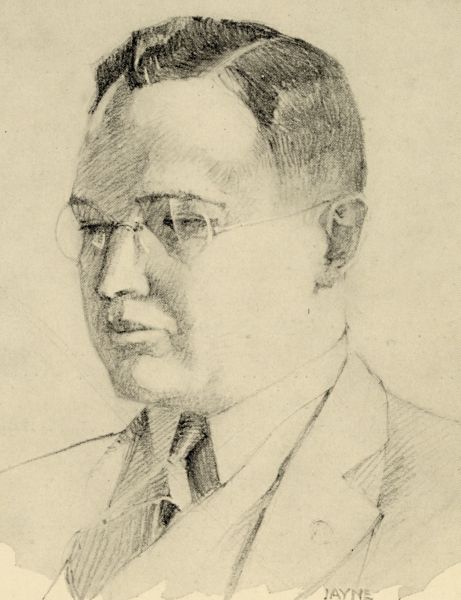 college…” Jayne in 1936 pushed for developing the art department, convincing the administration that it would provide a major contribution the liberal arts education. As a result, one course in art and one course in music were incorporated into the curriculum. During the 1970s Jayne donated over 1300 etchings, woodcuts and drawings by his uncle, renowned illustrator Allen Lewis (SC-60), who was also a distant cousin of James McNeill Whistler. Jayne’s painting, “Who Was That Shining One?” hangs in the Wheaton College Special Collections public area. It depicts missionaries Bob Ekvall and Ed Carlson’s encounter with frightened bandits in western China, who saw something mysterious that Ekvall and his companion did not see at the time.
college…” Jayne in 1936 pushed for developing the art department, convincing the administration that it would provide a major contribution the liberal arts education. As a result, one course in art and one course in music were incorporated into the curriculum. During the 1970s Jayne donated over 1300 etchings, woodcuts and drawings by his uncle, renowned illustrator Allen Lewis (SC-60), who was also a distant cousin of James McNeill Whistler. Jayne’s painting, “Who Was That Shining One?” hangs in the Wheaton College Special Collections public area. It depicts missionaries Bob Ekvall and Ed Carlson’s encounter with frightened bandits in western China, who saw something mysterious that Ekvall and his companion did not see at the time.
All posts by admin
Rite on!
 Generally, on alternating years Wheaton College Special Collections has hosted a conference examining the influence of Christian faith and traditions in the poetry and plays of William Shakespeare. Dr. Beatrice Batson, Professor Emerita of English at Wheaton College and Coordinator of the Shakespeare Special Collection, has invited accomplished scholars from all over the world to present papers exploring a suggested theme. These specialists typically address such issues as whether the Immortal Bard of Avon was Protestant or Catholic, or the presence of Christian reconciliation and other scriptural elements woven throughout his plots. After each conference Dr. Batson, acting as editor, collects the lectures into a book.
Generally, on alternating years Wheaton College Special Collections has hosted a conference examining the influence of Christian faith and traditions in the poetry and plays of William Shakespeare. Dr. Beatrice Batson, Professor Emerita of English at Wheaton College and Coordinator of the Shakespeare Special Collection, has invited accomplished scholars from all over the world to present papers exploring a suggested theme. These specialists typically address such issues as whether the Immortal Bard of Avon was Protestant or Catholic, or the presence of Christian reconciliation and other scriptural elements woven throughout his plots. After each conference Dr. Batson, acting as editor, collects the lectures into a book.
The most recent title, Word and Rite: The Bible and Ceremony in Selected Shakespearean Works (2010), produced by Cambridge Scholars Publishing, attempts to show something of the ways in which the Bible and Christianity intersect the language of Shakespeare. Word and Rite also focuses on the matter in which rites are efforts to illuminate mysteries: the mystery of marriage, the mystery of baptism, the mystery of confession, the mystery of the Eucharist, the mystery of funerals, and even the mystery of words in their relation to the Word. Holy objects such as the Fountain of blood are also considered. Contributors include Dr. Leland Ryken (“Shakespeare and the Bible”), Dr. Brett Foster (“‘Each letter in the Letter’: Textual Testimonies in Shakespeare”) and Dr. Jack Heller (“‘Your statue spouting blood’: Julius Caesar, the Sacraments, and the Fountain of Life”).
Reviewing the contents, Dr. Maurice Hunt, author of Shakespeare’s Romance of the Word and professor at Baylor University, states: “This book amounts to a fitting capstone of the several previously published Institute volumes of high-quality papers. Deserving special mention in this latest volume are Jeffrey Knapp’s fresh reading of Shakespeare’s sonnets as confessional autobiography, Grace Tiffany’s comprehensive analysis of the triumph of the English language over the French tongue in Shakespeare’s plays, Christopher Hodgkins’ eloquent account of Christian apocalyptic thought in The Tempest, and David George’s persuasive linking of the abbreviated rites and interrupted ceremonies typical of Shakespeare’s plays to the wars of religion waged in the playwright’s lifetime…Here we have a banquet – a smorgasbord – of commentary on Shakespeare’s art.”
The Shakespeare Special Collection (SC-34), housed at Wheaton College, is considered the premiere holding of secondary literature pertaining to the use of religion in the plays of William Shakespeare.
The Facts Will Appear in Due Time
Dr. Charles Blanchard’s ostensible obituary for the late R.J. Bennett, trustee and reliable benefactor, appears on the front page of the March 5, 1924, Record. Ever vigilant for additional funding, President Blanchard moves quickly from pious memorializing to a frank review of Bennett’s previous financial contributions to Wheaton College, and a rather anxious expectation for one more posthumous gift. It is not known whether the school received it.
Mr. R.J. Bennett, LLD of Pasadena, California, for many years a leading wholesale merchant in Chicago, recently passed away. Mr. Bennett was a member of Ravenswood Congregational Church and cooperated with most of the missionary churches of Chicago for many years. He was one of the most influential and useful members of the Board of Trustees of Wheaton College. He and Mr. Charles H. Case, also of Chicago, both on this board, were both men of large wealth and generous activities, and were among the most conservative and helpful of our trustees. Mr. Case gave to the college by will one-half the residuum of his estate. This has not yet been received, but is still in the courts. It is supposed that this provision will ultimately furnish Wheaton College one-hundred-ten or fifteen thousand dollars. Mr. Bennett died suddenly, painlessly, and restfully, after his long, honored, and useful life. It would be a long story to tell of the different college activities with which he has been associated. Improvements on the campus, the erection of the academy building, the increase of endowment funds, together with constant contributions, were a part of his work. We have heard a number of statements respecting his will which at the present time we are not able to confirm. Some two or three years ago Mr. Bennett said to us that at that time he was supposed to be worth about two-hundred-fifty thousand. A year ago or less when he was in Chicago he said to us that in his will he had provided for his family and personal friends and had directed that all the residuum of his estate should be paid to Wheaton College. We have not seen his will. It was offered for probate in California, February 27th. We have been told not on authority that the specified bequests amounted to something like one-hundred-twenty thousand dollars. If this should prove to be true, and if the amount of his estate has not changed materially from his statement to us several years since, the amount coming to the college would be very considerable, but we are not able to give more surmises and reports at this time. The facts will appear in due time.
Living on the Edge
 As the final section of his autobiography, Life is Mostly Edges (2008), Dr. Calvin Miller, pastor, poet and professor, asks the reader what he or she would do differently, if life could be repeated. At age 72 he answers the question for himself:
As the final section of his autobiography, Life is Mostly Edges (2008), Dr. Calvin Miller, pastor, poet and professor, asks the reader what he or she would do differently, if life could be repeated. At age 72 he answers the question for himself:
1. I would put more emphasis on being a better husband and father. To the church or the university I would whip out a lot more noes, and a lot more yesses to my family. I would eradicate almost all of the “Daddy’s-too-busies,” and the “later, darlings,” from my vocabulary. If the church suddenly came up with a critical meeting on circus night, I’d go to the circus.
2. I’d celebrate my mother in her presence. She was a simple woman whose humility kept her from seeing just how great she was. This adherence to her modesty I would shatter with the sledgehammer of praise. How would I do this?…I would write her a check for all the times she struggled to keep the family together…I would walk her to work in the morning and carry her lunch, and meet her when the day was over to tell her that I loved her…If anyone had maltreated her, I would get their address and visit them with an axe at midnight…For every time when I had made life hard for her, I would do seven years of penance…I would be there all the more for the woman who was always there for me.
3. I’d build a monument on Golgotha. I would build myself a replica of Golgotha, an Everest of Calvary, so high that the empty cross at its summit would be hidden by the mist of sheer altitude. I would keep a shrine at the top of my giant Calvary, with no sugary idols where the dying was done. I’d have no icons there, for the living Jesus who has been the central icon of my life would meet me there. When he came at sunrise, I would be there with the bread. And when he came at dusk, I would be there with the wine. And I would reverse my prayer life. I wouldn’t talk to him so much; I would listen more. I still wonder after a lifetime of chatty prayers, if I had not been so noisy in his presence, would he have told me more of his giant heart?
4. I’d babysit. Could I pass this way again I would take seriously a little girl in our church with whom I was hugging and laughing and having a great time, when suddenly she stopped my teasing her and asked point-blank, “Dr. Miller, do you ever do babysitting?” I told her I was too busy. But if I had to do all over again, I’d do more babysitting. In general I’d take more time for children and perhaps less for deacons.
5. What am I doing to be sure that I am a good steward of the years I have left? First, I am determined that this question will not drive me. One thing I do not want for the years I have left is to be so preoccupied with an agenda that I will not have time for anything but the drive…Such a tight little squinting of the eyes gobbles up our peripheral vision. It steals the panorama of what we might have seen if we had laid down some of our busy agenda and looked around a bit.
6. I’ll stop looking ahead and look around more. Looking around more will be my focus in my final years. I will smell the roses of Versailles and count the scent as sweet as those on the altar of the church. I will bypass a great many Christian novels and go on reading Pulitzer Prize winners just as I have always done. And I will not be so bent on my writing that I have no time to look around. I will not type my manuscripted way into the grave, staying so busy that I cannot take a walk with my wife, work the New York Times acrostic, go to a movie, or see a play…Looking around more means walking in a good direction but with an unhurried step. I would like to begin each day with God and then, coffee cup in hand, go out into the world. I don’t want to try and dissect it. I don’t want to figure it out. I just want to walk about in it. I also want to celebrate the simple things.
Miller, formerly pastor of Westside Baptist Church in Omaha, Nebraska, is currently Professor of Preaching and Pastoral Ministry at Samford University’s Beeson Divinity School. He has written over 40 books, including novels and poetry, notably The Singer and The Symphony trilogies. His papers (SC-24), comprising manuscripts, correspondence and watercolor artwork, are archived at Wheaton College (IL) Special Collections. He has lectured at Wheaton College on several occasions.
Among shadows and silvery light…
Alexander Grigolia, before resigning from the faculty of Wheaton College in 1945 to accept a professorship at Eastern Baptist Seminary, chaired the department of anthropology. During his nine years at Wheaton, Grigolia studied not only humanity, generally, but men and women, particularly as these unseasoned youth daily brushed elbows with him in the corridors of Blanchard Hall. His insights into human nature provided invaluable guidance for grateful students. For instance, cartoonist/evangelist Phil Saint remembers in his memoir, Saints Alive (1986):
But I had a mind to get me a wife while still at this school where so many lovely Christian girls were. So one day several months later I went to consult Dr. Alexander Grigolia, head of the department of anthropology. I respected this good man’s wisdom. “Well, Mr. Saint,” he said, “how things are going?” A European-trained scholar, he had a quaint way of inverting his word order. I knew what he meant. He also had a way of guessing what was on a person’s mind. “Well,” I answered, “I have a list of prospects…Of course,” I added, reddening, “they don’t know anything about this yet.” Looking seriously at me, Dr. Grigolia nodded. “Tell me who they are,” he said. I named several I deemed very nice Christian girls. When I came to Ruth Brooker, Doc brightened visibly. “Ah,” he declared, ” she is execkly feeted for your life! You must get her!” I didn’t really know Ruth very well, but his enthusiasm excited me. “Tell me more, Doc, tell me more!” I exclaimed. I listened with great interest. And as soon as I could I made a date with that girl. After just four dates I was wildly and hopelessly in love. Ruth’s spirit, her sparkling humor, every adorable change of her features as she talked or listened, were all I could dream about. For a whole week I found study impossible. My body went to classes, but my mind was preoccupied – with Ruth. Chaffing like a race horse at the starting gate, I waited for classes to finish so I could see her again. Putting my feelings into words as we sat one night on the porch swing at her home was the hardest thing I ever tried to do. The setting was perfect for a proposal. Moonlight threw a pattern of shadow and silvery light around us, and a soft breeze rustled the rose arbor. And Ruth was so near! After struggling for the right words, I finally gave up. Instead of proposing marriage, I just asked Ruth to pray about the future of our relationship. Ruth had already prayed and knew what it was. In the library the next morning, as I bent over to whisper something in her ear, I saw she was making up a list of bridesmaids!
Likewise, Billy Graham in his autobiography, Just as I Am (1997), writes that Grigolia was one of the primary reasons he decided to major in anthropology, a discipline that would stimulate empathy for differing religions and customs should the young evangelist enter the foreign mission field:
The head of the college’s new anthropology department was popular among the students, “Don’t leave Wheaton without a course in Grigolia” became a favorite saying. Short and rotund, with flashing dark eyes and an accent that hinted at his Russian birth, he had received one Ph.D in Germany and another at the University of Pennsylvania; he had a medical degree tucked in there somewhere too. In a corner of his crowded little office, ever watchful, stood his faithful colleague Josephine, with whom I was to make a quick acquaintance; she was a full-sized human skeleton. Dr. Grigolia ardently convinced us that the origins of the human race were not up from the ape but down from the hand of God, as Genesis recorded. His humorous mistakes in the King’s English were a continuous source of merriment. Once when he was at the blackboard and a couple of students were whispering to each other, he said, without turning around, “Would someone please pipe him down?”
End of Summer
Although the official Gregorian calendar doesn’t mark the beginning of the Fall equinox until September 21, we all know the tell-tale signs: tanned students back from summer break have returned to class, the temperatures are cooling, Labor Day is behind us, and white shoes are no longer seen in public. The Wheaton College Special Collections recently acquired an original Vaughn Shoemaker cartoon celebrating the days of summer. After some much needed conservation efforts, the print was scanned and is now housed in the Vaughn Shoemaker Collection. Shoemaker was a Pulitzer Prize-winning editorial cartoonist with the Chicago Daily News for thirty years. He is well-known for his John Q. Public character who depicts the common man.
View a video about Shoemaker.
Dr. Louis H. Evans, Sr.
William Evans, a native of England, heard D. L. Moody preach in New York City in 1890, and there received the gift of salvation in Christ. Advised by Moody to attend his new school in Chicago, Evans traveled to the Windy City, enrolled at Moody Bible Institute and graduated in 1892. He was, in fact, its first graduate. After a few years in various pastorates, he was appointed as Director of Bible at his alma mater. Aside from his classroom accomplishments, Dr. Evans contributed three lasting agents in the propagation of the gospel message. His first contributions were books titled How to Prepare Sermons (1917) and Great Doctrines of the Bible (1912), still in print through Moody Publishers.
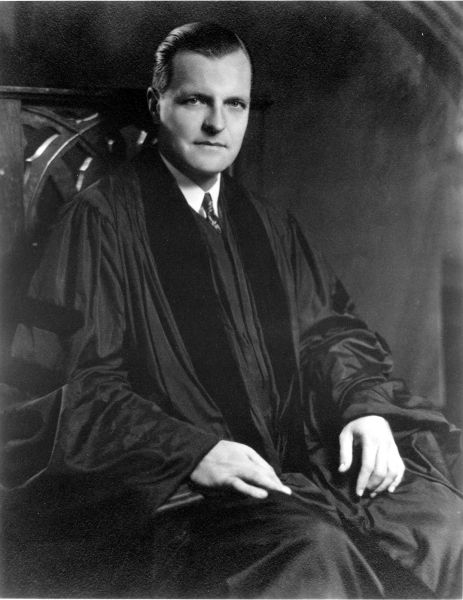 His other contribution was not a book but a son, named Louis Hadley Evans, who would one day be cited as one of the notable preachers of the twentieth century. Born in Goshen, Indiana, in 1897, Louis was raised in Wheaton, Illinois, in a house that stood on the corner of Franklin and Irving, where the Nicholas wing of Buswell Memorial Library now stands on the campus of Wheaton College. Louis attended Wheaton Academy, across the street from his home, for one year (1914-15), then later entered Occidental College in Los Angeles. A remarkable athlete, muscled and broad-shouldered at 6 ft. 4, he participated in football and basketball, winning multiple honors. After serving in the Navy during WW I, he acquired a theological education at McCormick Presbyterian Theological Seminary in Chicago. Ordained in the United Presbyterian Church, Evans led congregations in North Dakota, California and Pennsylvania. While serving as pastor at Third Presbyterian Church of Pittsburgh he received a call to Hollywood, California. Initially he found the request unappealing. “I said no at first when their call came,” he commented to Time magazine. “But later I realized it would be a burr in my saddle and that Hollywood would be one of the finest recruiting grounds in America. Also, I wanted to get my teeth into something.” When Evans assumed leadership at Hollywood Presbyterian in 1941, he found the church $250,000 in debt with a membership of 2,378. Within the first year the debt was wiped out, and for each successive year his parishioners topped their offerings, giving more than any other Presbyterian congregation in the U.S. As membership increased, swelling to the largest assembly in the denomination, so did Sunday School enrollment. Henrietta Mears, Director of Christian Education, was responsible for discipling these converts and implemented an engaging program that inspired hundreds of young people to enter full-time Christian activity; among these were Bill Bright, founder of Campus Crusade for Christ.
His other contribution was not a book but a son, named Louis Hadley Evans, who would one day be cited as one of the notable preachers of the twentieth century. Born in Goshen, Indiana, in 1897, Louis was raised in Wheaton, Illinois, in a house that stood on the corner of Franklin and Irving, where the Nicholas wing of Buswell Memorial Library now stands on the campus of Wheaton College. Louis attended Wheaton Academy, across the street from his home, for one year (1914-15), then later entered Occidental College in Los Angeles. A remarkable athlete, muscled and broad-shouldered at 6 ft. 4, he participated in football and basketball, winning multiple honors. After serving in the Navy during WW I, he acquired a theological education at McCormick Presbyterian Theological Seminary in Chicago. Ordained in the United Presbyterian Church, Evans led congregations in North Dakota, California and Pennsylvania. While serving as pastor at Third Presbyterian Church of Pittsburgh he received a call to Hollywood, California. Initially he found the request unappealing. “I said no at first when their call came,” he commented to Time magazine. “But later I realized it would be a burr in my saddle and that Hollywood would be one of the finest recruiting grounds in America. Also, I wanted to get my teeth into something.” When Evans assumed leadership at Hollywood Presbyterian in 1941, he found the church $250,000 in debt with a membership of 2,378. Within the first year the debt was wiped out, and for each successive year his parishioners topped their offerings, giving more than any other Presbyterian congregation in the U.S. As membership increased, swelling to the largest assembly in the denomination, so did Sunday School enrollment. Henrietta Mears, Director of Christian Education, was responsible for discipling these converts and implemented an engaging program that inspired hundreds of young people to enter full-time Christian activity; among these were Bill Bright, founder of Campus Crusade for Christ.
After serving for 12 years at Hollywood Presbyterian, Pastor Evans resigned in 1953, leaving a healthy congregation of 6,400 members. “It made a rancher out of me instead of a shepherd,” he joked. For the next nine years he traveled as Minister-at-Large for the National Board of the United Presbyterian Church, USA, speaking to universities, conventions and churches, often appearing on radio or television. As he journeyed from one engagement to another, his wife, Marie, usually drove as he sat in the back seat, tapping out sermon notes on a specially built typewriter stand. In addition to itinerating, he served as President Eisenhower’s summer pastor in Washington, DC, and was one of the co-founders and early president of the Fellowship of Christian Athletes. Life magazine named Evans as one of “America’s Twelve Outstanding Religious Leaders,” along with Billy Graham, Norman Vincent Peale, Fulton Sheen and George A. Buttrick. Writing eight books, he continued public ministry until four months before his death in 1981. His memorial service was officiated by Dr. Lloyd John Ogilvie, who also served as a pastor at Hollywood Presbyterian (1972-95) and eventually as Chaplain to the U.S. Senate. “Rolled into one man,” eulogized Ogilvie, “was the brilliance of an Apostle Paul, the impetuousness of a Peter, the love and tenderness of a Barnabas.”
The papers of Louis H. Evans, Sr. (SC-31), are archived at Wheaton College (IL) Special Collections. The collection is comprised of photographs, recordings and typewritten documents.
Remember the Birds
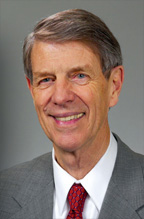 Dr. Jerry R. Kirk is former pastor of the College Hill Presbyterian Church in Cincinnati, Ohio. During his twenty-one year pastorate, in 1983 he founded the National Coalition Against Pornography, an alliance of citizen-action groups, foundations, and religious denominations leading the effort against child pornography, adult obscenity, sexual exploitation and violence. During that time he also co-founded the Religious Alliance Against Pornography (RAAP) with John Cardinal O’Connor of New York and Joseph Cardinal Bernardin of Chicago in 1986. In 1988 Jerry resigned his pastoral charge to commit his full-time energies to these efforts, now called the National Coalition for the Protection of Children & Families.
Dr. Jerry R. Kirk is former pastor of the College Hill Presbyterian Church in Cincinnati, Ohio. During his twenty-one year pastorate, in 1983 he founded the National Coalition Against Pornography, an alliance of citizen-action groups, foundations, and religious denominations leading the effort against child pornography, adult obscenity, sexual exploitation and violence. During that time he also co-founded the Religious Alliance Against Pornography (RAAP) with John Cardinal O’Connor of New York and Joseph Cardinal Bernardin of Chicago in 1986. In 1988 Jerry resigned his pastoral charge to commit his full-time energies to these efforts, now called the National Coalition for the Protection of Children & Families.
Dr. Kirk has worked with religious leaders representing more than 100 million Americans, from nearly every major denomination and faith group in the country, including the Jewish community, The Salvation Army, the National Council of Churches, the National Association of Evangelicals, the Roman Catholic Church, Greek Orthodox Church and Church of Jesus Christ of Latter-day Saints. He has met with Presidents Ronald Reagan and George H.W. Bush and three different Attorneys General (including Edwin Meese). Dr. Kirk is a frequent speaker on the problem of pornography, sexual exploitation and violence, appearing on Dr. James Dobson’s “Focus on the Family” radio program eleven times, as well as, “The Oprah Winfrey Show,” “NBC Nightly News” with Tom Brokaw, Moody Broadcasting’s “Prime Time America” and most recently on FamilyLife with Dennis Rainey.
A native of Seattle, Washington, Dr. Kirk attended the University of Washington and has earned two graduate degrees. He has written two books, The Homosexual Crisis in the Mainline Church, The Mind Polluters, and numerous articles. He and his wife, Patty currently reside in Cincinnati and have five children and twenty-two grandchildren.
[excerpted from National Coalition for the Protection of Children & Families and Leadership Magazine]
———————————————–
On February 16-17, 1994, Jerry Kirk spoke at Wheaton College for the Annual Staley Lecture series on the topic “The Christian Response to Pornography.” In his final chapel address on the theme ‘Knowing, Believing, Praying, and Living the Word of God,’ Kirk expounded on the love of God from Ephesians 3 and presented a powerful illustration.
I’ve tried to think how can I receive God’s love more constantly? One of my [church] members told me one day that every time she saw a cardinal she would stop and say “I love you,” putting the words in the lips of Jesus. So I started searching for cardinals…but you know I didn’t see enough cardinals, so I put up a bird feeder outside my office window and I’d see ten or fifteen cardinals every day. Then I decided I ought to do that anytime I see any bird. Everyday, every time I see a bird I thank Jesus Christ for His love. Seventy-five to one-hundred fifty times every day I receive the love of Christ. If you’ll do that for one week, you’ll never stop.
[Artwork by Matthew Cook]
![]() (mp3 – 00:29:05, illustration starts at 17:05)
(mp3 – 00:29:05, illustration starts at 17:05)
David Aikman’s book on Graham in paperback
 Billy Graham: His Life and Influence (Thomas Nelson, June 2010) examines Graham’s impact on the worldwide development of Christianity, international affairs and the fall of Communism. Author and former TIME Magazine senior correspondent David Aikman integrates his Christian faith and understanding of world affairs into this careful analysis of Graham’s ministry. Aikman examines critical episodes of Graham’s life that explain his impact on American public life and the private lives of world leaders.
Billy Graham: His Life and Influence (Thomas Nelson, June 2010) examines Graham’s impact on the worldwide development of Christianity, international affairs and the fall of Communism. Author and former TIME Magazine senior correspondent David Aikman integrates his Christian faith and understanding of world affairs into this careful analysis of Graham’s ministry. Aikman examines critical episodes of Graham’s life that explain his impact on American public life and the private lives of world leaders.
David Barrington Thomson Aikman was born on June 6, 1944, the same night as the Normandy invasion, in Cobham, Surrey, England. Dr. Aikman received his early education at Stowe School in Bucks, England. He was graduated with honors in Russian and French from Worcester College, Oxford, received his M.A. in Far Eastern Languages and Literature (Mongolian and Turkish) from the Far Eastern and Russian Institute of the University of Washington, Seattle and also received his Ph.D. in Russian and Chinese history from the University of Washington.
He began his twenty-three year career with TIME magazine in 1971, reporting from five continents and more than 55 countries. As foreign and Senior Correspondent he interviewed major world figures like Mother Teresa, Alexander Solzhenitsyn, Boris Yeltsin and Billy Graham. He was bureau chief in Berlin, Jerusalem and Beijing aided by his skill in speaking Russian, Chinese, French, and German. He is an expert on China, Eastern Asia, and the former Soviet Union. From 1998 to 2002 Aikman was a Senior Fellow at the Washington-based Ethics and Public Policy Center. Additionally, he served as editor-at-large of Newsroom, an Internet-based news organization reporting on the religious aspect of news events around the world.
 David Aikman has been an eyewitness to the rise and fall of nations and regimes. Based in Hong Kong in the early 1970s, he saw first-hand the fall of Indo-china to Communist rule. He was the last correspondent to leave Phnom Penh before the Khmer Rouge invaded in 1975. While Eastern European Bureau Chief, Aikman also covered the emergence of dissident groups in Poland. Aikman was familiar with many of the people who became advisers to Polish President Lech Walesa. Dr. Aikman has also been Bureau Chief in Jerusalem, during the invasion of Lebanon by Israel; Beijing, during the reforms of Deng Xiaoping and the last days of the pro-democracy movement in Tiananmen Square; and in Moscow, during the Chernobyl disaster and the beginning of Yeltsin’s loyal opposition movement in 1989.
David Aikman has been an eyewitness to the rise and fall of nations and regimes. Based in Hong Kong in the early 1970s, he saw first-hand the fall of Indo-china to Communist rule. He was the last correspondent to leave Phnom Penh before the Khmer Rouge invaded in 1975. While Eastern European Bureau Chief, Aikman also covered the emergence of dissident groups in Poland. Aikman was familiar with many of the people who became advisers to Polish President Lech Walesa. Dr. Aikman has also been Bureau Chief in Jerusalem, during the invasion of Lebanon by Israel; Beijing, during the reforms of Deng Xiaoping and the last days of the pro-democracy movement in Tiananmen Square; and in Moscow, during the Chernobyl disaster and the beginning of Yeltsin’s loyal opposition movement in 1989.
David Aikman is also an accomplished public speaker, appearing regularly on major C-SPAN, CNN, NBC and others. His speaking has focused on the Middle East, China and on religious persecution around the world. The David Aikman Papers are housed in the Wheaton College Archives & Special Collections.
[excerpted from David Aikman.com and David Aikman Papers]
S.S. Victory Wheaton
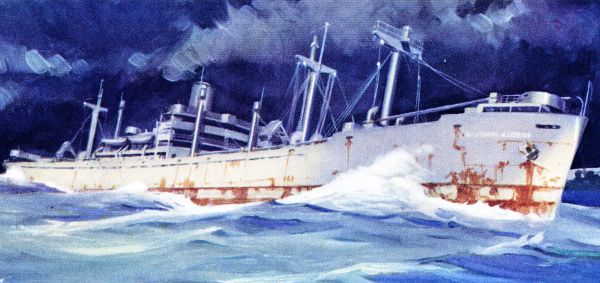
| painting by DeWitt Whistler Jayne ’36 |
Constructed by the California Shipbuilding Corporation yard on Terminal Island, California, the S.S Victory Wheaton set sail on March 22, 1945. Chosen by the U.S. Maritime Commission, it was one of a series of Victory ships named after America’s oldest educational institutions with student enrollment over 500. As with all ships of it class (officially VC2), the S.S. Victory Wheaton was 455 feet long and 62 feet wide. Her cross-compound steam turbine with double reduction gears developed 6,000 (AP2 type) or 8,500 (AP3s type) horsepower, allowing it great advantage in speed over its predecessor, the Liberty ship. Mrs. Kenneth Godwin, wife of the Executive Office of the Bureau of Yards and Docks of San Francisco, christened the vessel. Wheaton was represented at the ceremony by the Reverend John Shearer, ’39, pastor of North Hollywood Presbyterian Church and Chaplain L.J. Soerhide, U.S.N.R., ’39. A new Victory Ship memorial has been developed in Florida. Wheaton will have a plaque recognizing it along with the other schools for which Victory ships were named.
